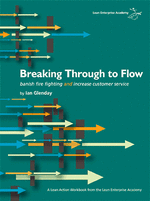
Description
Is this workbook for you?
In your organisation …
- Are daily or weekly plans and schedules ever changed after being an issue?
- Is the prime focus of LEAN eliminating waste?
- Is the accuracy of demand forecasting an issue?
- Would “fire fighting” be an appropriate term to describe the way things are, at times, done?
If you answer YES to one or more of the above,
-this workbook is for you, your colleagues and the organisation you all work in.
Forward by Daniel T Jones
If you want to become truly lean but cannot imagine how to get beyond the fire-fighting associated with constantly changing plans, then this workbook is for you. A growing number of people are recognising that there is a lot more to lean than simply eliminating waste from current processes. But they struggle to see how to redesign their operations and abandon old ways of working. This workbook introduces a new pathway that is helping many organisations to overcome this hurdle and to launch them on the next phase of their lean journey – breaking through to flow.
The key starting point for this pathway is to question the batch logic, based on economic order quantities, that drives most planning systems. Batch logic creates a vicious circle where every change leads to a new plan, which in turn leads to further changes and fire-fighting. This workbook describes how it is possible to move step by step towards levelled production and later on to produce in line with customer demand. This simultaneously creates the stability essential in driving a virtuous circle of standard work, continuous improvement and increased performance.
Every business is actually a collection of different product flows. This workbook introduces a tool and a management system, which we have come to call the Glenday Sieve, which enables you to quickly create a stable flow and replenishment pull system for the few products that account for a significant part of your output, while managing separately the tail of build-to-order products with low volume and unpredictable demand. Over time more products can be added to this flow, and the cost of product complexity can be reduced.
I first met Ian Glenday and came across this pathway over a decade ago, while writing Lean Thinking. He was at the time working in a company making various food products. I was just getting involved in rethinking the grocery supply chain with Tesco. It puzzled me why food manufacturers glazed over when you talked about single piece flow and synchronised production. They understood cost reduction, which they had been doing for years, but could not imagine synchronising production to demand, because of the chaotic order signals they were receiving from retailers. This situation is beginning to change as Tesco and others introduce continuous store replenishment systems and pick up products from their suppliers every day. The time is now ripe to create lean flow logic in supply chains across a wide range of industries. This workbook shows you how.
While it is perhaps not surprising that this pathway was first developed in a process industry, our research tells us that it is also very helpful in many different environments. These range from dealing with insurance claims to organising the service and repair of cars, to managing the flow of patients through hospital departments. The key translation in applying the Glenday sieve outside manufacturing involves analysing tasks to be performed rather than products to be made. The skill lies in repeatedly sieving these tasks using different criteria to reveal the underlying flows going through the organisation.
Ian started developing this pathway many years ago out of his own experiences in pharmaceuticals and food production. He later met Yoshiki Iwata, the founder of Shingijutsu, who at Toyota Gosei was one of the first Toyota Group suppliers to be taught the Toyota Production System by Taiichi Ohno and his team. He showed Ian the steps of levelling Toyota used to get to one-piece-flow and encouraged him to develop his ideas further. Ian then spent many years learning all the change management skills necessary to help people make this breakthrough to flow. You have the end result in your hand.
This is not a workbook on the Toyota Production System. It is a pathway that helps people make a fundamental change in their thinking and working that is at the heart of lean – moving from batch to flow logic. The Sieve helps to identify the right value streams to map using the Learning to See workbook by Mike Rother and John Shook. You will also need all the other lean tools described in Creating Continuous Flow, Making Materials Flow and elsewhere to achieve a succession of future state value streams. And it will help you appreciate the full significance of the different types of pull systems described in the Creating Level Pull workbook by Art Smalley.
This workbook describes a big step change in thinking and doing. We know from experience making these steps in different organisations can very quickly lead to big improvements in performance as well as releasing a lot of enthusiasm in people to carry on down the path to flow. We have learnt over time that the only things that stick are those you do yourselves. It is now up to you to see what this pathway can do for you. Let Peter Walsh know your experiences and any lessons you have learnt on the way at pwalsh@lean.org.au. I wish you the best of luck.
To purchase as e-book for Kindle click the following link: Breaking Through to Flow: banish fire fighting and increase customer service
